
Toxicodendron is a genus of flowering plants in the sumac family, Anacardiaceae. It contains trees, shrubs and woody vines, including poison ivy, poison oak, and the lacquer tree. All members of the genus produce the skin-irritating oil urushiol, which can cause a severe allergic reaction. The generic name is derived from the Greek words τοξικός (toxikos), meaning "poison," and δένδρον (dendron), meaning "tree". The best known members of the genus in North America are poison ivy (T. radicans), practically ubiquitous throughout most of eastern North America, and western poison oak, similarly ubiquitous throughout much of the western part of the continent.

Toxicodendron radicans, commonly known as eastern poison ivy or poison ivy, is an allergenic Asian and Eastern North American flowering plant in the genus Toxicodendron. The species is well known for causing urushiol-induced contact dermatitis, an itchy, irritating, and sometimes painful rash, in most people who touch it. The rash is caused by urushiol, a clear liquid compound in the plant's sap. The species is variable in its appearance and habit, and despite its common name, it is not a true ivy (Hedera), but rather a member of the cashew and pistachio family (Anacardiaceae). T. radicans is commonly eaten by many animals, and the seeds are consumed by birds, but poison ivy is most often thought of as an unwelcome weed. It is a different species from western poison ivy, Toxicodendron rydbergii, which has similar effects.

The Araliaceae is a family of flowering plants composed of about 43 genera and approximately 1500 species consisting of primarily woody plants and some herbaceous plants. The morphology of Araliaceae varies widely, but it is predominantly distinguishable based on its woody habit, tropical distribution, and the presence of simple umbels.

Hedera, commonly called ivy, is a genus of 12–15 species of evergreen climbing or ground-creeping woody plants in the family Araliaceae, native to western, central and southern Europe, Macaronesia, northwestern Africa and across central-southern Asia east to Japan and Taiwan.
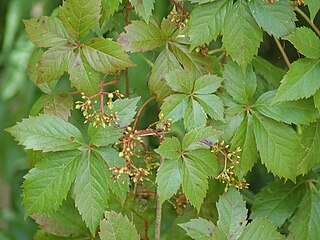
Parthenocissus quinquefolia, known as Virginia creeper, Victoria creeper, five-leaved ivy, or five-finger, is a species of flowering plant in the grape family, Vitaceae. It is native to eastern and central North America, from southeastern Canada and the eastern United States west to Manitoba and Utah, and south to eastern Mexico and Guatemala.

Hedera hibernica, common name Atlantic ivy or Irish ivy, is a woody vine native to the Atlantic coast of Europe.

Hedera helix, the common ivy, English ivy, European ivy, or just ivy, is a species of flowering plant of the ivy genus in the family Araliaceae, native to most of Europe and western Asia. A rampant, clinging evergreen vine, it is a familiar sight in gardens, waste spaces, and wild areas, where it grows on walls, fences, tree trunks, etc. across its native and introduced habitats. As a result of its hardy nature, and its tendency to grow readily without human assistance, English ivy attained popularity as an ornamental plant, but escaped plants have become naturalised outside its native range and grow unchecked in myriad wild and cultivated areas.

Fatsia japonica, also glossy-leaf paper plant, fatsi, paperplant, false castor oil plant, or Japanese aralia, is a species of flowering plant in the family Araliaceae, native to southern Japan and southern Korea.

Schefflera taiwaniana (台湾鹅掌柴) is a species of flowering plant in the family Araliaceae, native to Taiwan, where it is scattered throughout coniferous forests at 2,000–3,000 m (6,600–9,800 ft). Growing to 4 m (13 ft) tall by 2.5 m (8.2 ft) broad, it is an evergreen shrub or small tree. Large leaves up to 15 cm (5.9 in) long are composed of up to 11 ovate leaflets arranged radially around a central stalk. Young leaves are covered in silver hairs, while mature leaves have a smooth surface. Sprays of flowers in late summer are followed by dark berries in winter - a valued food source for insects and birds.

Hedera nepalensis is a species of perennial Ivy native to Nepal and Bhutan, as well as Afghanistan, Pakistan, India, China, Laos, Myanmar, Thailand, and Vietnam, at altitudes of about 1000–3000 m. Plants grow up to 30 m in height, with simple leaves ranging from 2–15 cm long, and yellow flowers.
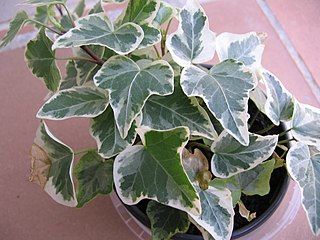
Hedera algeriensis, the Algerian ivy, is a species of evergreen ivy native to the North African coast, including coastal mountains in Algeria.

Hedera canariensis is a species of ivy which is native to the Atlantic coast in Canary islands and northern Africa. Its common name is the Canarian ivy.

Hedera maroccana, the Moroccan ivy, is a species of ivy which is native to the Atlantic coast in northern Africa. It is an evergreen climbing plant, growing to 20–30 m high where suitable surfaces are available, and also growing as ground cover where there are no vertical surfaces. It climbs by means of aerial rootlets which cling to the substrate. In warm climates, it grows more rapidly and becomes established a good bit faster than the related Hedera hibernica and Hedera helix.

Hedera colchica is a species of ivy which is native to Near and Middle East. It is commonly called Persian ivy or colchis ivy. It is an evergreen climbing plant, growing to 30 m high where suitable surfaces are available, and also growing as ground cover where there are no vertical surfaces. It climbs by means of aerial rootlets which cling to the substrate. In warm climates, it grows more rapidly and becomes established faster than other Hedera species.

Hedera iberica is a species of ivy which is native to the western Iberian peninsula, and northern Morocco. It was formerly classified as a sub-species named Hedera maderensis iberica in Hedera maderensis. The Iberian subspecies was subsequently classified as a distinct species. It grows on slopes, rock, soil, trunks of trees.

Hedera azorica is a species of ivy which is native to the Atlantic coast in Azores Islands. Its common name is Ivy. It is an evergreen climbing plant, growing to 20–30 m high where suitable surfaces are available, and grows as ground cover where there are no vertical surfaces. It climbs by means of aerial rootlets which cling to the substrate.
Hedera cypria, is a species of Ivy which is endemic to the island of Cyprus. It is an evergreen climbing plant, growing slowly to 20–30 m high where suitable surfaces are available, and also growing as ground cover where there are no vertical surfaces. It climbs by means of aerial rootlets which cling to the substrate. It is more common at higher altitudes in rocky, shadowy riverine forest, over 400–650 m. In its natural habitat it can be distinguished easily from Hedera helix subsp. poetarum, also present, because the latter has yellow fruits, while Hedera cypria is always black-fruited.
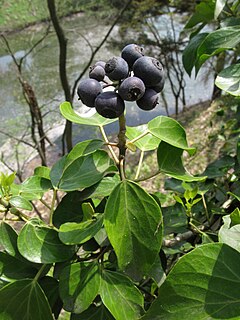
Hedera rhombea, the Japanese ivy or songak, is a species of ivy in the Araliaceae family native to East Asia. Formerly named Hedera pedunculata, some subspecies could be subsequently classified as a distinct species. It is common on rocky slopes and growing up the trunks of trees, especially in laurel forest, a type of cloud forest.
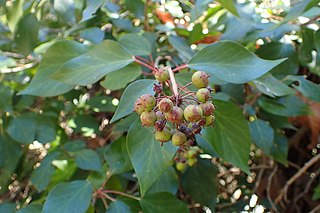
Hedera pastuchovii, (Araliaceae) is a species of ivy native to eastern Transcaucasia and listed in The Red Book of the Azerbaijan SSR, 1989.
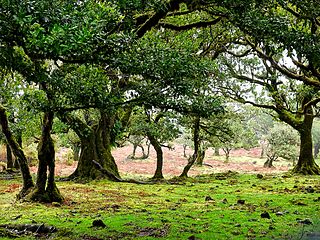
The Madeira evergreen forests is a temperate broadleaf and mixed forests ecoregion of southwestern Europe. It covers the archipelago of Madeira and some nearby islands in the Atlantic Ocean. Laurel forest, known as laurissilva, once covered the islands. Over centuries the forests were mostly cleared. Madeira's remaining forests are now protected.


















